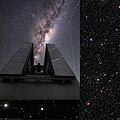File:ESO Telescopes Spy a Rare Relic.jpg

Original file (5,000 × 5,000 pixels, file size: 8.12 MB, MIME type: image/jpeg)
Captions
Captions
Summary[edit]
| DescriptionESO Telescopes Spy a Rare Relic.jpg |
English: The Milky Way contains hundreds of billions of stars. However, the star at the centre of this image still manages to be very unusual — no mean feat!
A Brazilian–American team led by Jorge Melendez, from the University of São Paulo used two of ESO’s telescopes in Chile to discover that this star, named 2MASS J18082002–5104378, is a rare relic from the Milky Way’s formative years. As such, it offers astronomers a precious opportunity to explore the first stars that sprung to life within our galaxy. 2MASS J18082002–5104378 was spotted in 2014 by ESO’s New Technology Telescope (NTT). Follow-up observations using ESO’s Very Large Telescope (VLT) discovered that, unlike younger stars such as the Sun, this star shows an unusually low abundance of what astronomers curiously call metals — elements heavier than hydrogen and helium. In fact, it is so devoid of these elements that it is known as an UMP, or an ultra metal-poor star — the brightest ever discovered! Although thought to be ubiquitous in the early Universe, metal-poor stars are now a rare sight within both the Milky Way (eso1132) and other nearby galaxies. Metals are formed during nuclear fusion within stars, and are spread throughout the interstellar medium when these stars grow old and explode. Subsequent generations of stars therefore form from increasingly metal-rich material. Metal-poor stars, however, formed from the unpolluted environment that existed shortly after the Big Bang. Exploring stars such as 2MASS J18082002–5104378 may unlock secrets about their formation, and show what the Universe was like at the very beginning. The results have been published in Astronomy & Astrophysics. The involved team consisted of Jorge Meléndez (Universidade de São Paulo, IAG, Brazil), Vinicius M. Placco (University of Notre Dame, Department of Physics and JINA Center for the Evolution of the Elements, USA), Marcelo Tucci-Maia (Universidade de São Paulo, IAG, Brazil), Iván Ramírez (University of Texas at Austin, McDonald Observatory and Department of Astronomy, USA), Ting S. Li (Texas A&M University, Department of Physics and Astronomy, USA), and Gabriel Perez (Universidade de São Paulo, IAG, Brazil). |
| Date | |
| Source | http://www.eso.org/public/images/potw1603a/ |
| Author | ESO/Beletsky/DSS1 + DSS2 + 2MASS |
Licensing[edit]
 |
This media was created by the European Southern Observatory (ESO).
Their website states: "Unless specifically noted, the images, videos, and music distributed on the public ESO website, along with the texts of press releases, announcements, pictures of the week, blog posts and captions, are licensed under a Creative Commons Attribution 4.0 International License, and may on a non-exclusive basis be reproduced without fee provided the credit is clear and visible." To the uploader: You must provide a link (URL) to the original file and the authorship information if available. |
This file is licensed under the Creative Commons Attribution 4.0 International license.
| |
File history
Click on a date/time to view the file as it appeared at that time.
| Date/Time | Thumbnail | Dimensions | User | Comment | |
|---|---|---|---|---|---|
| current | 07:27, 10 August 2019 |  | 5,000 × 5,000 (8.12 MB) | BevinKacon (talk | contribs) | actual size from ESO original source |
| 11:49, 21 January 2016 |  | 1,280 × 1,280 (524 KB) | Jmencisom (talk | contribs) | User created page with UploadWizard |
You cannot overwrite this file.
File usage on Commons
The following page uses this file:
- File:ESO Telescopes Spy a Rare Relic (24516200375).jpg (file redirect)
Metadata
This file contains additional information such as Exif metadata which may have been added by the digital camera, scanner, or software program used to create or digitize it. If the file has been modified from its original state, some details such as the timestamp may not fully reflect those of the original file. The timestamp is only as accurate as the clock in the camera, and it may be completely wrong.
| Credit/Provider | ESO/Beletsky/DSS1 + DSS2 + 2MASS |
|---|---|
| Source | European Southern Observatory |
| Usage terms |
|
| Short title |
|
| Image title |
|
| Date and time of data generation | 06:00, 18 January 2016 |
| Software used | Adobe Photoshop CC 2015 (Windows) |
| Copyright status | Copyright status not set |
| Unique ID of original document | xmp.did:dff47eb2-53c7-3248-9109-d75a8f0b8a40 |
| Contact information |
Karl-Schwarzschild-Strasse 2 Garching bei München, , D-85748 Germany |
| Keywords | 2MASS J18082002–5104378 |
| IIM version | 4 |